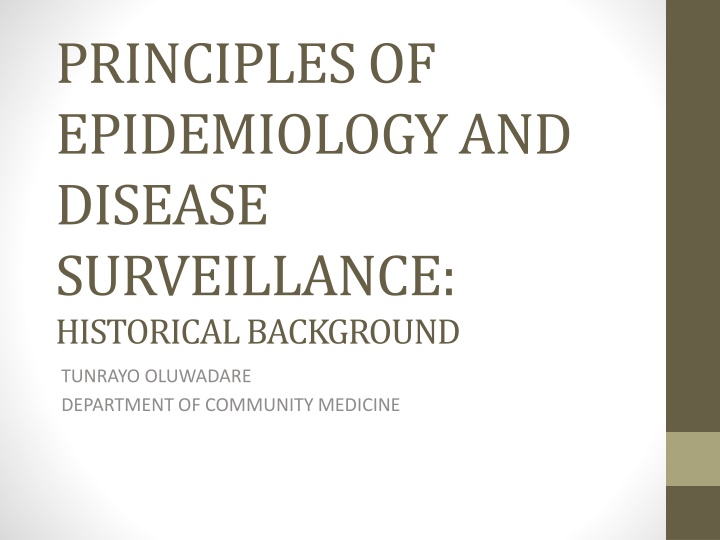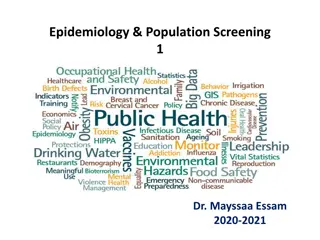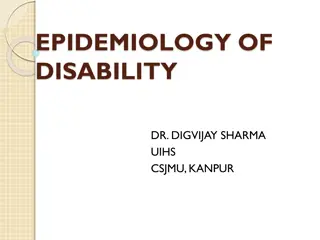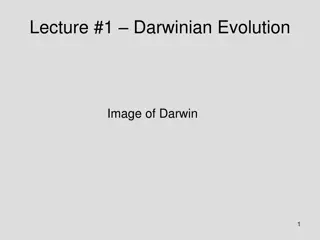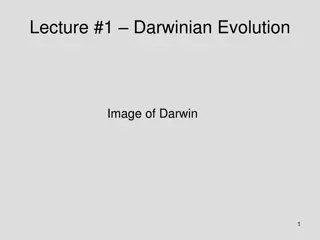Evolution of Epidemiology: Historical Perspectives and Contributions
The evolution of epidemiology spans centuries, beginning with Hippocrates in 400 BC and progressing through key figures like John Graunt, James Lind, Edward Jenner, John Snow, and others. From the observation-based practices of ancient times to the groundbreaking experiments and analyses of the 17th-19th centuries, epidemiologists have played a crucial role in understanding disease occurrence and transmission. This historical development paved the way for modern disease surveillance and public health practices.
Download Presentation

Please find below an Image/Link to download the presentation.
The content on the website is provided AS IS for your information and personal use only. It may not be sold, licensed, or shared on other websites without obtaining consent from the author.If you encounter any issues during the download, it is possible that the publisher has removed the file from their server.
You are allowed to download the files provided on this website for personal or commercial use, subject to the condition that they are used lawfully. All files are the property of their respective owners.
The content on the website is provided AS IS for your information and personal use only. It may not be sold, licensed, or shared on other websites without obtaining consent from the author.
E N D
Presentation Transcript
PRINCIPLES OF EPIDEMIOLOGY AND DISEASE SURVEILLANCE: HISTORICAL BACKGROUND TUNRAYO OLUWADARE DEPARTMENT OF COMMUNITY MEDICINE
EVOLUTIONARY PROCESS It has grown from PURE OBSERVATIONS AND ADVICES (Hippocrates) COUNTING OF CASES AND ANALYSIS (John Graunt & William Farr) NATURAL EXPERIMENTS (John Snow) TRUE EXPERIMENTS Lind, Jenner, Fletcher, Doll &Hill & Other epidemiologists in the last two century
GROWTH FROM 17TH -19TH CENTURY PERIOD EPIDEMIOLOGIST CONTRIBUTION 1600AD JOHN GRAUNT LONDON BILLS OF MORTALITY ANALYSIS 1747 JAMES LIND CITRUS FRUITS TO CURE SCURVY IN SAILORS 1796 EDWARD JENNER TRIAL WITH COWPOX VACCINE GROWTH 17TH -19TH CENTURIES W.H. FROST 1880 EXPLAINED INTERPLAY OF FACTORS CAUSING EPIDEMICS 1889 WILLIAM FARR ANALYSIS OF VITAL STATISTICS & EFFECTS OF IMPRISONMENT IN PRISONERS 1849 JOHN SNOW NATURAL EXPERIMENT ON LONDON CHOLERA 1881 FINLAY MOSQUITO BORNE NATURE OF YELLOW FEVER 1900 BRADFORD HILL .A CONCEPT OF RANDOMIZATION & SMOKING AND LUNG CANCER EXPERIMENTS.
Historical development Hippocrates 400BC he explained disease occurrence from a rational rather than a supernatural viewpoint He wrote an essay titled On Airs, Waters, and Places Environmental and host factors might influence the development of disease.
Historical development contd. Hippocrates contd. He advised that factors causing disease be searched Air (hot &cold winds) Water (marshy, soft, hard, from rocky soil, unfit for cooking) Places (naked without vegetation, deficient in water, well watered, elevated and cold) Personal habits
Historical development contd. John Graunt ( 1600AD) A London tradesman and founding member of the Royal Society of London He became the first epidemiologist, statistician, and demographer Summarized the Bills of Mortality for his 1662 publication. This publication was the first to quantify patterns of birth, death, and disease occurrence, noting disparities between males and females, high infant mortality, urban/rural differences, and seasonal variations.
Historical development contd. John Graunt ( 1600AD) He counted the mortality rates for 37 years in London from the Bills of mortality and found .Constancy in the ratio from male to female in births and deaths. Age specific mortality is higher among males than in females. Seasonal fluctuations in deaths from various causes.
Historical development contd. John Graunt ( 1600AD) Measured the ebb and flow of various diseases and the host factors. Suggested quantitative methods to test the hypothesis of this variations.
Historical development contd. James Lind (1716- 1794) A Scottish Naval Surgeon, conducted a true experiment on his 12 soldiers suffering from Scurvy Vinegar Mixture of nutmeg, garlic, mustard and tamarind in barley water Elixir vitrol Seawater Cider Two oranges and one lemon
Historical development contd. Edward Jenner (1796) Was an English Physician The first person to immunize against smallpox with cowpox vaccine His discovery paved way for preventive medicine and epidemiology.
Historical development contd. William Farr (1807-1883) He is considered one of the founders of modern epidemiology The father of modern vital statistics and surveillance Farr was the compiler of Statistical Abstracts for the General Registry Office in Great Britain from 1839 through 1880. He analyzed the vital statistics for 40 years and made valuable observations with regard to the then health situation and recommended their application for public health improvement.
Historical development contd. William Farr (1807-1883) contd. He found high mortality in certain occupations like miners. He studied the health of prisoners and found that while 8 only died due to executions, 52 died of imprisonment. He also found that fluctuations in marriage rates depend upon price of bread, cholera, population movements and person s monetary value.
Historical development contd. William Farr (1807-1883) contd. His findings paved the way for proper health planning and policies and thus fostered epidemiology and occupational health and safety.
Historical development contd. John Snow (1813-1858) He was a Physician for Queen Victoria and a a great epidemiologist He is considered the father of field epidemiology Controlled cholera in London He was able to prove his hypothesis by means of natural experiment that contaminated water is the vehicle for cholera spread.
Historical development contd. Fletcher (1905) Fletcher studied Beriberi that occurred in lunatics in mental asylum in Kuala Lumpur (Malaysia) and proved that it is due to nutritional deficiency. He used parboiled rice and Siamese rice for his true experiment.
Historical development contd. Goldberger Joseph (1915) He proved that Pellagra is not an infectious disease as it was thought earlier, but a nutritional deficiency state.
Historical development contd. Modern epidemiology In the 1930s and 40s epidemiologists extended their methods to non infectious diseases. The study of Richard Doll and Bradford Hill In 1980s epidemiologists extended the study to injuries and violence.
Historical development contd. Modern epidemiology contd. In 1990s it was extended to related of molecular and genetic epidemiology. Today, health workers throughout the world accept and use epidemiology, regularly to characterize the health of the communities and to solve day-day problems, large and small.
